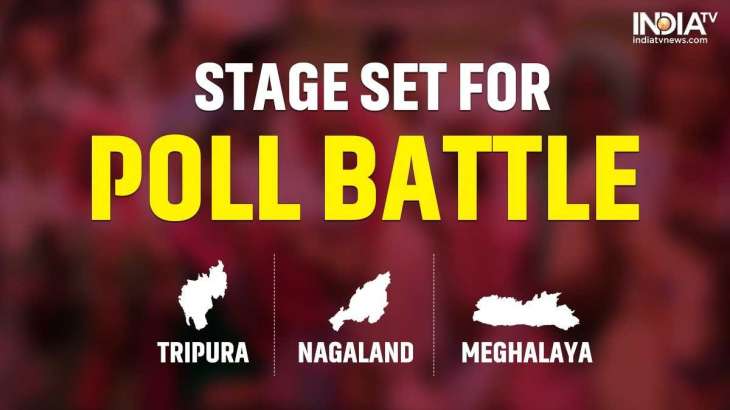
by Nilofar Suhrawardy 7 March 2023
Electoral verdict displayed during recently held polls in Meghalaya, Nagaland and Tripura clearly suggest that regional parties in these north-eastern states cannot be ignored. The importance accorded by Bharatiya Janata Party (BJP) to these results as not simply its “success” but more as marking major defeat of Congress, demands an analysis of these results from this angle itself. Of these, perhaps the most important is the trend displayed by Meghalaya polls. The importance given by BJP to this state is apparently marked by Prime Minister Narendra Modi’s decision to attend the swearing in ceremony of the chief minister here. BJP has won only two seats from here against the five won by Congress. While BJP has secured 9.3% votes here, 13.14% have favored Congress. Statistically, this trend is hardly suggestive of BJP having fared better than Congress. Compared to preceding polls conducted in 2018, of course the Congress has registered a major fall. In 2018, Congress had won 21 seats on strength of 28.5% votes. BJP’s performance was more or less same as has been now. It secured two seats and 9.6% votes. What perhaps bears greater significance is the increase in number of votes as well as seats won by regional parties of Meghalaya. National People’s Party (NPP) has won 26 seats with 31.6% votes against 20 seats and 20.6% votes it won in 2018. United Democratic Party (UDP) has won 11 seats (16.2% votes) while in 2018 it secured six seats (11.6% votes). It is possible, the decline in percentage of votes and seats secured by Congress is partly due to greater importance given by voters to regional parties in recent polls. Also, if NPP had not fallen five short of crossing the majority mark (31 seats) to form the state government, the question of it seeking support of other parties would not have risen. Whatsoever may be “hype” raised by BJP about its success here, its victory on just two still leave NPP short of three seats.
Regional parties’ political hold cannot be side-lined in Nagaland also. In these elections, National Democratic Progressive Party (NDPP) has won 25 seats (32.22% votes) in comparison to 18 seats (25.2% votes), this party won in preceding polls. In 2018, Naga People’s Front (NPF) won 26 seats (38.8% votes), while this time it managed only two seats with 7.9% votes. Though BJP has won only 12 seats in both polls, there has been an increase in percentage of votes won by it, with it being 15.3% in 2018 and 18.8% this time. Congress failed to register any win in 2018 as well as in 2023 with a slight increase in votes gained by it from 2.1% in 2018 to 3.5% now. Simply speaking, against gains registered by regional parties, seats won by BJP carry little significance.
Undeniably, Tripura’s politics convey a different message. BJP’s return to power in this state rests on its own strength. It has won 32 seats with 39% votes while in 2018 it secured 36 seats on basis of 43.5% votes. BJP’s key rival Communist Party of India-Marxist (CPM) has managed only 11 seats with 24.62% votes against 16 (42.22% votes), it won in 2018. While Congress drew a blank in 2018 securing less than two percent votes, during these elections it has won three seats with 8.56% votes. Nevertheless, regional politics has not failed to display its presence here too. This is marked by two-year-old Tipra Motha Party (TMP) winning 13 seats polling around 19% votes, signaling its debut as the second largest party in Tripura Assembly.
Though BJP’s victory in 60-member Tripura Assembly stands out markedly, the same cannot be said about it having won only 12 and two seats in Nagaland and Meghalaya, respectively with each having 60-member Assembly. Election to one seat- Sohiong constituency- in Meghalaya was adjourned due to death of a candidate. The noise made about Congress having failed in these states would probably have had greater or at least some credibility if these were viewed as strongholds of this party and/or had it been ousted from power in either of these states because of these electoral results.
Perhaps, rather than basking upon what seems to be manufactured glory of these electoral results, BJP needs to pay greater attention to what it has failed to hold on to and gains of Congress in bypolls.
Political analysts and media haven’t failed to take note of Congress having won from Pune’s Kasba Peth, viewed as BJP stronghold in Maharashtra, as the latter had held this seat for 28 years. This has been won by Ravindra Dhangekar (Congress) with 73,194 votes against 62,244 received by Hemant Rasane (BJP). However, BJP’s Ashwini Laxman Jagtap has won the bypoll in Maharashtra’s Chinchwad with a massive margin of 36168 votes against Vitthal alias Nana Kate of Nationalist Congress Party (NCP). Tamil Nadu’s Erode bypoll has been won by E.V.K.S. Elangovan of Congress with AIADMK’s R.G. Annaadhurai trailing by a margin of 66,233 votes. In West Bengal, Congress candidate Bayron Biswas has wrested Sagardighi from Trinamool Congress Party (TMC). Debashish Banerjee (TMC) has lost this seat with a margin of 22,986 votes. In Arunachal Pradesh, BJP – candidate Mayralborn Syiem has been elected unopposed from Lumla. In Jharkhand, Congress candidate Bajrang Mahto has failed against Sunita Choudhary of All Jharkhand Students Union (AJSU) from Ramgarh.
Electoral results of these bypolls, are hardly suggestive of Congress having failed miserably against its key rivals. But yes, there is no denying that BJP is trying to make its presence more strongly in Meghalaya, Nagaland and Tripura. However, as suggested earlier, strength of regional parties cannot be sidelined in either of these states. While in Tripura, less than 40% voters have supported BJP, fewer than 20% in Nagaland and lesser than 10% have opted for it Meghalaya. In other words, statistical analysis of these electoral results is hardly suggestive of BJP having swayed the people’s support in its favor totally or even significantly!
